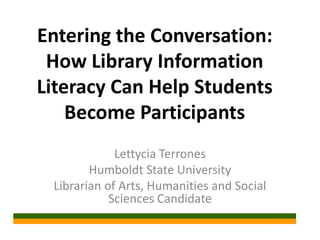
Terrones entering the conversation ppt
- 1. Entering the Conversation: How Library Information Literacy Can Help Students Become Participants Lettycia Terrones Humboldt State University Librarian of Arts, Humanities and Social Sciences Candidate
- 2. Entering the Conversation Writing is not playing someone else's game. Successful writing involves the creation and framing of your own questions about the sources you've chosen. You want to attend to the assignment at the same time that you locate and articulate your own, particular interest in it. (Rodburg, 1999) Rodburg, M. (1999). Moving from Assignment to Topic. Retrieved from http://www.fas.harvard.edu/~wricntr/documents/Topic.html
- 3. ACRL Info Literacy Competency Standards for Higher Education Determine the information need Access information effectively and efficiently Evaluate information and its sources critically Use information effectively to accomplish a specific purpose Understand issues surrounding the use of information, and access/use information ethically Association of College and Research Libraries. (2002). Information literacy competency standards for higher education. Chicago, IL: ALA. Retrieved from http://www.ala.org/acrl/sites/ala.org.acrl/files/content/standards/standards.pdf
- 4. InfoLit How to Equip Students Research question Keywords/Subject headings Accessing sources Evaluate & Use information Understand ethics of info access and use = Participation (CREATE!)
- 5. Critical Thinking … is PRESENT in all steps of the research process! Critical Thinking & Information Literacy are not in competition, but rather compliment each other.
- 6. Information Literacy: Techniques Model specific tools and skills Student centered learning Investigative exercises Collaborative efforts to problem solve Reflection of research experience Practice in evaluation and use of information L.Terrones LIBR 250 Course Webpage http://calstatela.libguides.com/terrones_libr250
- 7. Students as Participants Learner-Centered-Teaching asks the instructor to “facilitate and guide learners … to do the work of learning, to become actively involved in the material to be learned, and to then create their own understanding of that material.” (Kaplowitz, 2012, p. 8) *Equipping students to “Enter into the Conversation!”
- 8. Information Literacy Opportunities: Course integrated instruction Library workshops – high need, high interest Workshops: Citation formatting, Evaluating Websites, Bibliographic Management, Social Media Savvy Unit course on information literacy Online information literacy tutorials
- 9. Collection Development Survey faculty to assess collection needs and evaluate existing resources. Meet with faculty to ensure that the collection supports curriculum goals. Communicate with faculty when resources and materials become available. From: Guidelines for liaison work in managing collection and services. (2010). Reference and User Services Association, ALA. Retrieved from http://www.ala.org/rusa/resources/guidelines/guidelinesliaison
- 10. Outreach Forming Student Success Partnerships with: Writing Center Educational Opportunity Program Student Groups
- 11. Collaborative Efforts It is crucial that critical thinkers who want to change our teaching practices talk to one another, collaborate in a discussion that crosses boundaries and creates a space for intervention. (hooks, 1994, p. 129)
- 12. Professional Service Publishing goals • Info Literacy and Critical Thinking intersections • Collaborations between library services and Student Support Services University Contributions • Participate in University governing groups and work teams
- 13. HSU Mission, Vision and Values Excellence in teaching. Preparing students to be responsible members of diverse societies. Seek to improve the human condition and our environment.
- 14. References Association of College and Research Libraries. (2002). Information literacy competency standards for higher education. Chicago, IL: ALA. Retrieved from http://www.ala.org/acrl/sites/ala.org.acrl/files/content/standards/standards.pdf Guidelines for liaison work in managing collection and services. (2010). Reference and User Services Association, ALA. Retrieved from http://www.ala.org/rusa/resources/guidelines/guidelinesliaison hooks, b. (1994). Teaching to transgress: Educations as the practice of freedom. New York, NY: Routledge. Humboldt State University. (n.d.) Mission, vision and values. Retrieved from http://www.humboldt.edu/president/vision Kaplowitz, J. R. (2012). Transforming information literacy instruction using learner-centered teaching. London, England: Facet Publishing. Rodburg, M. (1999). Moving from assignment to topic. Retrieved from http://www.fas.harvard.edu/~wricntr/documents/Topic.html Shelley, A. (2009). Beyond buzz words and skillsets: The role of critical thinking in information literacy. Library Student Journal, 4, 8. Retrieved from http://www.librarystudentjournal.org/index.php/lsj Weiner, J. M. (2011). Is there a difference between critical thinking and information literacy?: A systematic review 2000-2009. Journal of Information Literacy, 5, 81-92. Retrieved from http://ojs.lboro.ac.uk/ojs/index.php/JIL